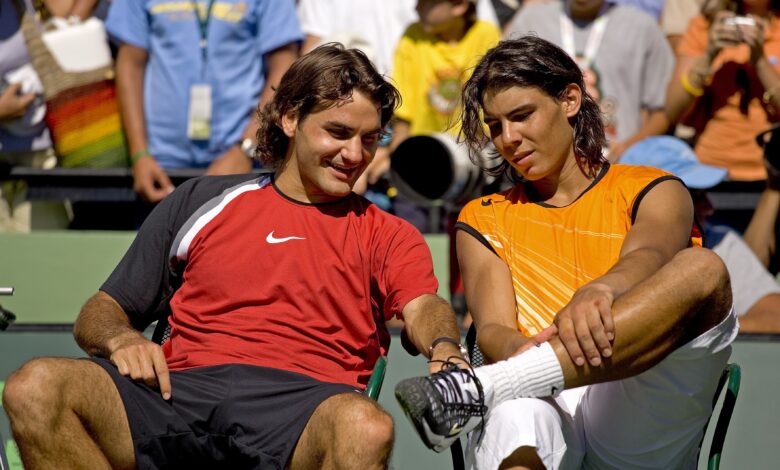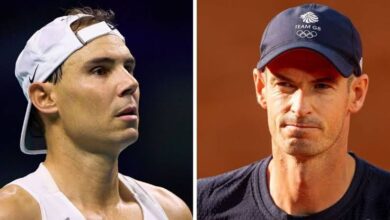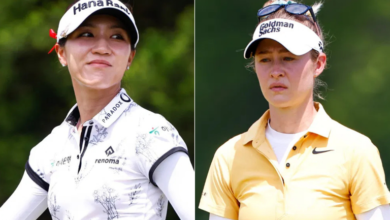Top 5 Miami Finals, No. 1: Roger Federer d. Rafael Nadal, 2005
The epic clash was the start of a new rivalry—and a new era for tennis.

This week, we’re counting down the Top 5 Miami finals (see our Top 5 Indian Wells finals here)
No. 5: Andy Murray d. David Ferrer, 2013
No. 4: Venus Williams d. Jennifer Capriati, 2001
No. 3: Pete Sampras d. Gustavo Kuerten, 2000
No. 2: Serena Williams d. Justine Henin, 2007
No. 1: Roger Federer d. Rafael Nadal, 2005
Wimbledon, Roland Garros, Rome, Melbourne: These are the historic tennis locations we usually associate with matches between Roger Federer and Rafael Nadal. But their rivalry started in Miami, 20 years ago. The Swiss and the Spaniard played the first of their 40 meetings at Crandon Park in 2004. Twelve months later they played their second match, and the first of their 24 finals, on the same court.
The second meeting was also their first classic encounter, and the first to give us an idea of what was to come over the next decade and a half. The four-hour, five-set epic also introduced millions of tennis fans to Nadal. He was just 18, he was playing in his first Masters 1000 final, and he was still three months from his first title at Roland Garros. Rafa didn’t have any trouble getting people’s attention. His loud, sleeveless shirts and long pirate pants were something new for the sport, as were his leaping fist-pumps and cries of “Vamos!”
Most startling of all was the way Nadal faced up to Federer, something that not many of his fellow pros were capable of at the time. Federer had been No. 1 for more than a year, and was coming off a season in which he won three major titles. Yet it was Rafa who jumped out of the gates drilling ground-stroke winners from both sides, and who won the first set 6-2. The conventional wisdom has always been that Nadal’s ability to hit left-handed forehand into Federer’s one-handed backhand was the main reason he had such success against him. While that dynamic was part of this match, it was Rafa’s diving, precise passing shots that did the most damage. Even when Federer came in behind a forehand, Nadal had the answer in the early going.
This match unfolded in a similar way to their most famous encounter, the 2008 Wimbledon final. Both times, Nadal came out hot and won the first set; both times, Federer weathered the storm and went up a break in the second; and both times Nadal came back to steal that set and go up two sets to love. In Miami, Rafa didn’t stop there. He went up 4-1 in the third, and seemed to be a lock to win. On one trip to the net, Federer looked so discouraged that he basically stopped running after yet another winning Nadal pass.
“It’s tough being down two sets to love,” Federer said. “You know he’s confident…I was really hoping to just stay with him.” Federer would eventually become famous for his comebacks from two sets down, but as of 2005 he had only done it twice. In this case, he got a little help from Nadal, who finally betrayed some nerves, and hit some tentative shots, with the finish line in sight. Nadal let the 4-1 lead slip, as well as a lead in the third-set tiebreaker. When his nervy backhand sailed long at 5-6, it was Federer’s turn to pump his fist and show a little swagger on his way to the sideline. He was back in it.
In fact, Federer had broken through the dam and turned the tide completely. He would drop just four more games over the final two sets, as he found the range on his forehand, and a tired Nadal was a step slower on defense. After the final point, the joy and relief from Federer were palpable as he threw his arm up in celebration of his first win over Rafa.
“This is a big moment in my career,” Federer said, acknowledging the challenge that Nadal posed. “Especially in the finals against a player of this caliber, to really come back, this is not the normal thing I’m doing.” Wins over Rafa wouldn’t be a “normal thing” for Federer for another decade—after this match, he lost five straight to him. But playing with the grit and belief needed to make comebacks and win big finals would become a prime part of his legend.



